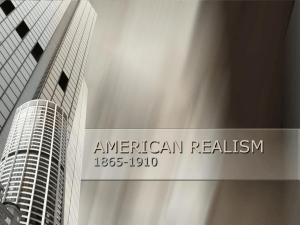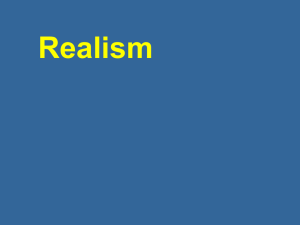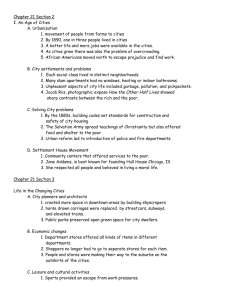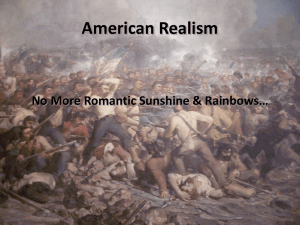The Harper Handbook of Literature
advertisement
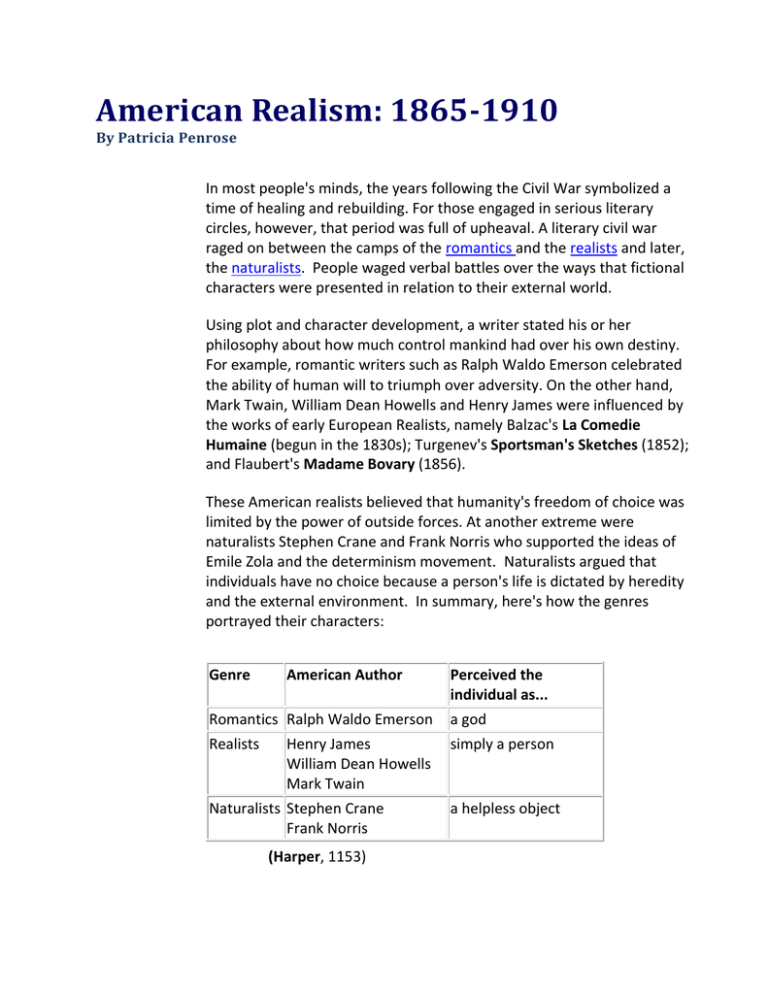
American Realism: 1865-1910 By Patricia Penrose In most people's minds, the years following the Civil War symbolized a time of healing and rebuilding. For those engaged in serious literary circles, however, that period was full of upheaval. A literary civil war raged on between the camps of the romantics and the realists and later, the naturalists. People waged verbal battles over the ways that fictional characters were presented in relation to their external world. Using plot and character development, a writer stated his or her philosophy about how much control mankind had over his own destiny. For example, romantic writers such as Ralph Waldo Emerson celebrated the ability of human will to triumph over adversity. On the other hand, Mark Twain, William Dean Howells and Henry James were influenced by the works of early European Realists, namely Balzac's La Comedie Humaine (begun in the 1830s); Turgenev's Sportsman's Sketches (1852); and Flaubert's Madame Bovary (1856). These American realists believed that humanity's freedom of choice was limited by the power of outside forces. At another extreme were naturalists Stephen Crane and Frank Norris who supported the ideas of Emile Zola and the determinism movement. Naturalists argued that individuals have no choice because a person's life is dictated by heredity and the external environment. In summary, here's how the genres portrayed their characters: Genre American Author Perceived the individual as... Romantics Ralph Waldo Emerson a god Realists simply a person Henry James William Dean Howells Mark Twain Naturalists Stephen Crane Frank Norris (Harper, 1153) a helpless object Emergence of American Realism The industrial revolution that took place at the end of the 19 th century changed our country in remarkable ways. People left rural homes for opportunities in urban cities. With the development of new machinery and equipment, the U.S. economy became more focused on factory production; Americans did not have to chiefly rely on farming and agriculture to support their families. At the same time, immigrants from all over the world crowded into tenements to take advantage of new urban opportunities. In the end, the sweeping economic, social, and political changes that took place in post-war life allowed American Realism to prevail. The realism of the 1880s featured the works of Twain, Howells and James among other writers. American Realists concentrated their writing on select groups or subjects. Examples of this practice include: o o o The factory workers of Upton Sinclair and Rebecca Harding David Paul Lawrence Dunbar and Charles Chesnutt's stories of black life Kate Chopin's views of marriage and women's roles The writing during this period was also very regional. The industrial revolution called for standardization, mass production of goods and streamlined channels of distribution. America was leaping into a new modern age and people feared that local folkways and traditions would be soon forgotten. Responding to these sentiments, realistic writers set their stories in specific American regions, rushing to capture the "local color" before it was lost. They drew upon the sometimes grim realities of everyday life, showing the breakdown of traditional values and the growing plight of the new urban poor. American realists built their plots and characters around people's ordinary, everyday lives. Additionally, their works contained regional dialects and extensive dialogue which connected well with the public. As a result, readers were attracted to the realists because they saw their own struggles in print. Conversely, the public had little patience for the slow paced narratives, allegory and symbolism of the romantic writers. America was shifting into higher gear and readers wanted writers who clearly communicated the complexities of their human experiences. Spurring Change At its basic level, realism was grounded in the faithful reporting of all facets of everyday American life. According to William Dean Howells, "Realism is nothing more and nothing less than the truthful treatment of material" (Carter, 36). The reading public's preference for realism parallels the changes that were occurring at the end of the 19th and into the 20th century. For example, the modern scientific revolution advocated that truth and knowledge be based on empirical data. Reinforcing that notion, the industrial revolution proclaimed that a better civil society could be built upon machinery and factory labor. Given this atmosphere, several developments occurred around the same time: (1)The growth of investigative journalism; (2) the rise of muckrakers; and (3) the establishment of a new-found fascination with the camera as a means of capturing the realities of a single instant, unvarnished by sentimentality. In many ways, these turn of the century developments are still alive and well. With regard to contemporary literature, realism is so pervasive that it seems natural and unimportant. However, upon close examination, we realize that realism planted the seeds for many of America's core values. Basic Tenets As with all literary genres, we cannot rely on generalizations to interpret a work. After all, realistic literature reflected more than mere external reality. According to Richard Chase's The American Novel and Its Tradition, realism has specific social, political, and artistic characteristics that set it apart from other genres. Below are the salient points that Chase makes about realism: Plot and Character Character is more important than action and plot; complex ethical choices are often the subject. Characters appear in the real complexity of temperament and motive; they are in explicable relation to nature, to each other, to their social class, to their own past. Humans control their destinies; characters act on their environment rather than simply reacting to it. Renders reality closely and in comprehensive detail. Selective presentation of reality with an emphasis on verisimilitude, even at the expense of a well-made plot. Events will usually be plausible. Realistic novels avoid the sensational, dramatic elements of naturalistic novels and romances. Class is important; the novel has traditionally served the interests and aspirations of an insurgent middle class. Interpretation and Analysis Realism is viewed as a realization of democracy. The morality of Realism is intrinsic, integral, relativistic – relations between people and society are explored. Realists were pragmatic, relativistic, democratic and experimental. The purpose of writing is to instruct and to entertain. Structure of Prose Diction is the natural vernacular, not heightened or poetic; tone may be comic, satiric, or matter-of-fact. The use of symbolism is controlled and limited; the realists depend more on the use of images. Objectivity in presentation becomes increasingly important: overt authorial comments or intrusions diminish as the century progresses. Other Important Aspects Interior or psychological realism is a variant form. Realism of James and Twain critically acclaimed in the twentieth century; Howellsian realism fell into disfavor as part of an early twentieth century rebellion against the "genteel tradition." Works Cited Carter, Everett. Howells and the Age of Realism . Philadelphia: Lippincott, 1954. Chase, Richard. The American Novel and Its Tradition. Garden City, NY: Doubleday, 1957 "The Literature of an Expanding Nation." The Harper American Literature. Donald McQuade, editor. New York: Harper & Row, 1987. Definitions Determinism is the philosophical belief that events are shaped by forces beyond the control of human beings. Scientific Determinism , important to literature at the end of the nineteenth century (see Naturalism), assigns control especially to heredity and environment, without seeking their origins further than science can trace. (The Harper Handbook of Literature) Muckrakers were American journalists and novelists of the first decade of the twentieth century who exposed corruption in big business and government. Theodore Roosevelt invented the term in a 1906 speech, agreeing with some of the muckrakers' findings but deploring the methods as irresponsible sensationalism. He alluded to the "man with a Muck-rake" in John Bunyan's Pilgrim's Progress (1678), who could look only downward as he stirred the filth, unable to see the heavenly crown held above him. Mass circulation magazines such as The Arena, Colliers, Cosmopolitan, Everybody's, The Independent, and McClures financed the investigations and published the work of muckrakers Lincoln Steffens, Ida Tarbell, David Graham Phillips, Ray Stannard Baker, T.W. Lawson, Mark Sullivan, and Samuel Hopkins Adams. Examples of muckraking novels include: Phillips' Great God Success (1901); Upton Sinclair's Jungle (1901); and the later books of the American Winston Churchill. (The Harper Handbook of Literature) Naturalism was a literary movement of the late nineteenth century that yielded influence on the twentieth. It was an extension of realism, a reaction against the restrictions inherent in the realistic emphasis on the ordinary, as naturalists insisted that the extraordinary is real, too. In place of the middle-class realities of a George Eliot, or a William Dean Howells, the naturalists wrote about the fringes of society, the criminal, the fallen, the down-and-out, earning as one definition of their work the phrase sordid realism. Naturalism came largely from scientific Determinism. Darwinism was especially important to the genre, as the naturalists perceived a person's fate as the product of blind external or biological forces (chiefly heredity and environment). But in the typical naturalistic novel, change played a large part as well. (The Harper Handbook of Literature) Romanticism was a movement in literature that celebrated the individual. Romantics believed in humankind's innate goodness and eventual perfectibility. The genre accepted experimentation as an expression of an artist's individuality. For example, Romantic literature discarded the formality of the closed heroic couplet and embraced a lyrical openness of style. In essence, the Romantic view was egalitarian. Equal at birth, inherently good, valued as individuals, all people were encouraged toward self-development. Romanticism stressed the value of expressing human abilities that were common to all from birth rather than from training. Thus, emotional, intuitive, and sensual elements of artistic, religious, and intellectual expression were counted in some ways more valid than the products of education and reason. Romanticism embraced nature as a model for harmony in society and art. Jean Jacques Rousseau is considered the father of romanticism. His noble savage characterized an idealized vision of humanity freed from the stifling boundaries of civilization. (The Harper Handbook of Literature) Patricia Penrose is currently the librarian at Nogales High School in La Puente, California.

